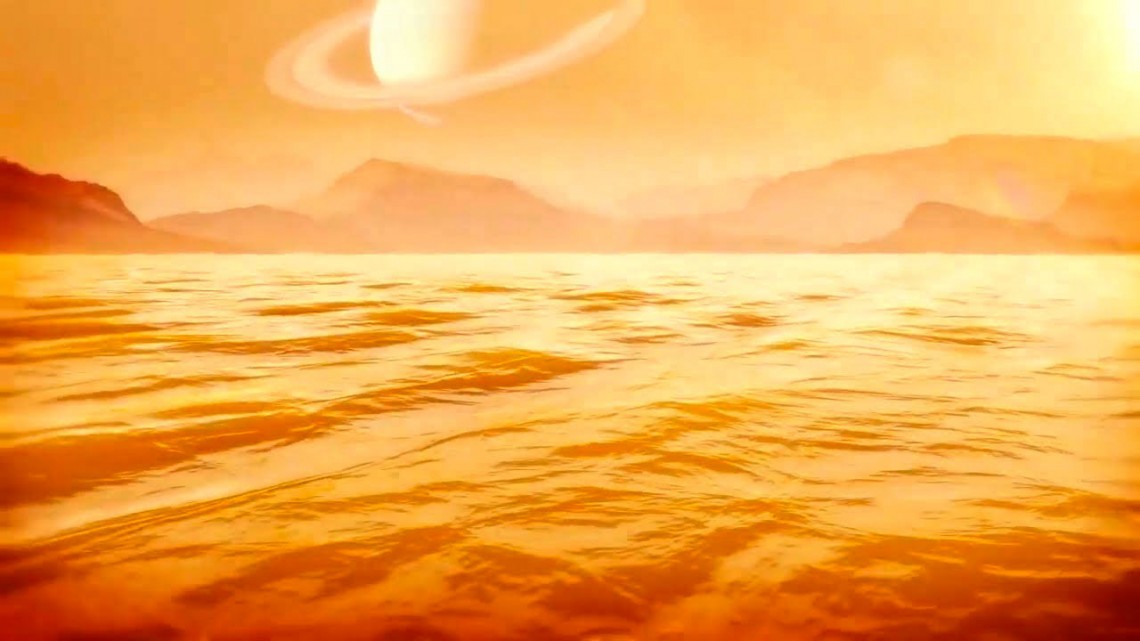How deep is Titan’s largest lake?
Saturn’s moon Titan is one of the most mysterious celestial bodies in the solar system. Beneath the golden haze of gaseous nitrogen in which it is enveloped, it has a weather cycle comparable to Earth’s – only not with water, but with liquid methane. The methane comes down from the sky as rain, flows down the mountains in rivers, forms lakes and oceans, and evaporates from them back into the atmosphere.
In a new paper in the Journal of Geophysical Research, researchers now use data from one of the Cassini mission’s last Titan flybys to show how deep Titan’s largest sea should be.
“The depth and composition of each of Titan’s seas has already been measured, with the exception of Titan’s largest sea, the Kraken Mare – which not only has a great name, but also contains about 80 percent of the moon’s surface liquid,” says lead author Valerio Poggiali, a research associate at the Cornell Center for Astrophysics and Planetary Science (CCAPS).
Data for the discovery were collected during Cassini’s T104 flyby of Titan on Aug. 21, 2014. The spacecraft’s radar was investigating Ligeia Mare – a smaller sea in the moon’s northern polar region – to search for the mysteriously disappearing and reappearing “magic island.”
While Cassini cruised nearly 1,000 kilometers (600 miles) above Titan’s surface at a speed of 20,000 kilometers per hour (13,000 mph), the spacecraft used its radar altimeter to measure the depth of liquid in Kraken Mare and Moray Sinus, an inlet at the northern end of the sea. The Cornell scientists, working with engineers at NASA’s Jet Propulsion Laboratory, had figured out how to detect the bathymetry (depth) of the lake and sea by determining the differences in radar return time on the fluid surface and seafloor, and the composition of the sea based on the amount of radar energy absorbed by the fluid during transit.
The radar waves were absorbed to such an extent that the fluid composition is consistent with 70% methane, 16% nitrogen, and 14% ethane (assuming ideal mixing). Analysis of the altitude data in the main body of Kraken Mare showed no evidence of signal returns from the seafloor, suggesting that the fluid is either too deep or too absorbent for Cassini’s radio waves to penetrate. However, if the fluid in the main body of Kraken Mare has a composition similar to that in Moray Sinus, as one would expect, then the bottom of Kraken Mare lies at a depth of more than 100 meters (300 feet). It is likely that the sea is even as deep as 300 meters.
Previous scientists had speculated that Kraken might be more ethane-rich, both because of its size and its extension into the lower latitudes of the Moon. The observation that the fluid composition is not significantly different from other northern seas is an important finding that will help assess models of Titan’s Earth-like hydrologic system.
One mystery is the origin of the liquid methane. Sunlight on Titan – about 100 times less intense than on Earth – constantly converts methane in the atmosphere to ethane; over a period of about 10 million years, this process would completely deplete the supplies on Titan’s surface, Poggiali said.
In the distant future, a submarine – probably without mechanical propulsion – will visit and cruise Kraken Mare, Poggiali says. “Thanks to our measurements, scientists can now derive the density of the liquid with higher precision and consequently better calibrate the sonar on board the ship and understand the directional currents of the sea.”
